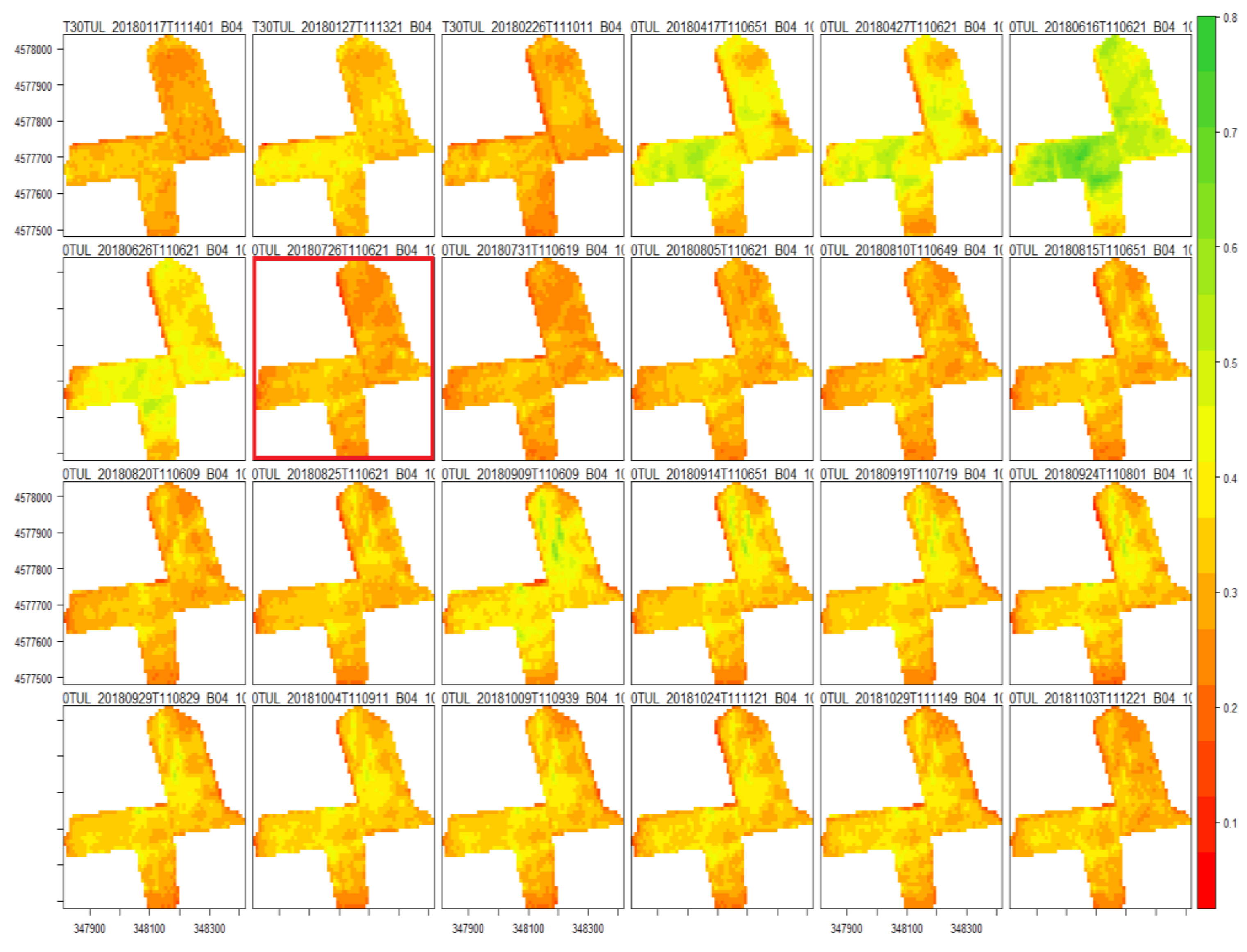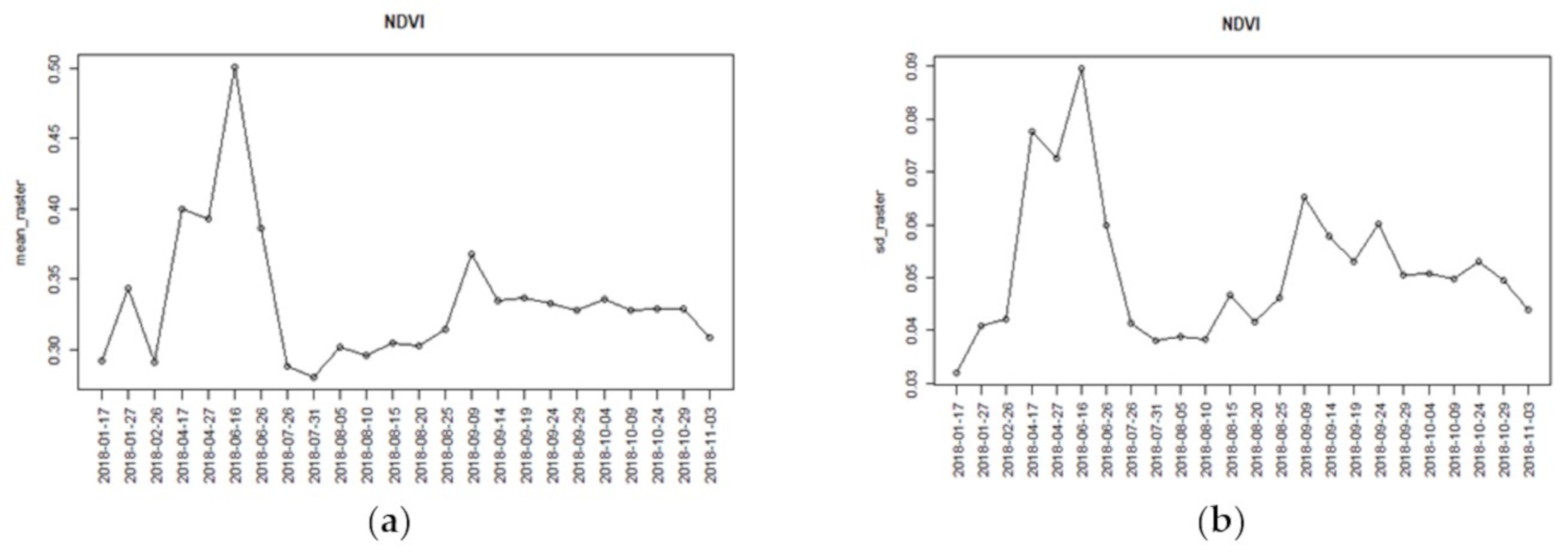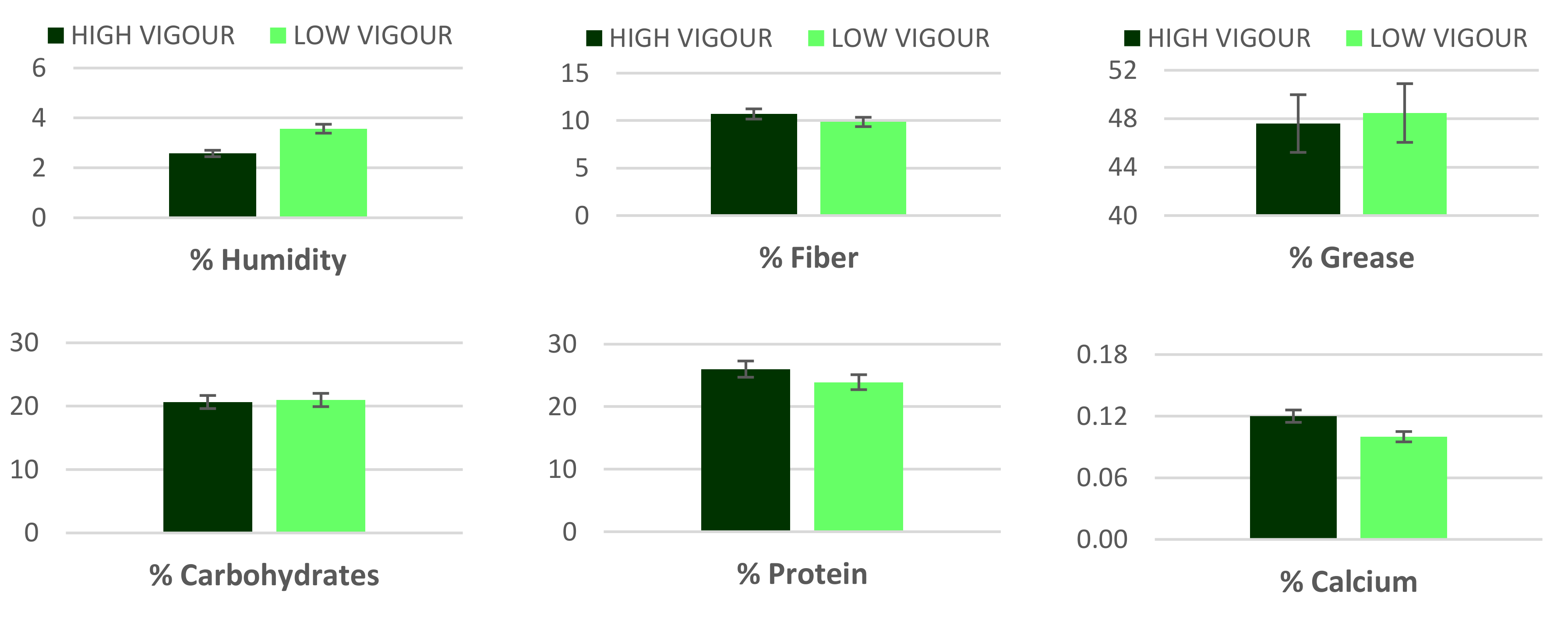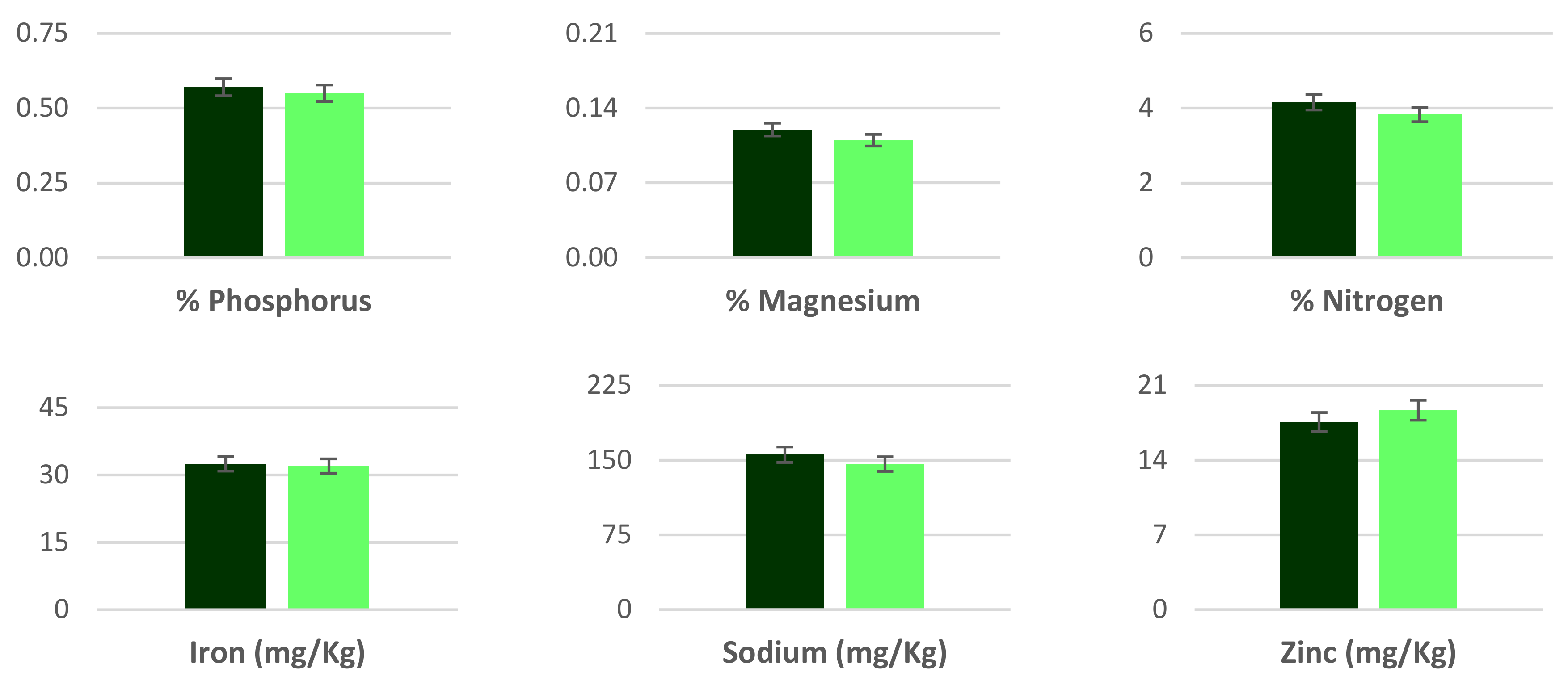Sentinel-2 Satellite Imagery for Agronomic and Quality Variability Assessment of Pistachio (Pistacia vera L.)
Abstract
1. Introduction
2. Materials and Methods
- D: appearance of clusters between the bracts;
- E: cluster opening;
- F0: reddish ovaries;
- F1: yellow colouring of the bottom of the nut mesocarp;
- F2: yellow mesocarp;
- M: detachment of the nut epicarp.
3. Results
3.1. Agronomic Study
3.2. Phenological Study
3.3. Nutritional Quality Study
3.4. Triangular Tasting
4. Discussion
5. Conclusions
Author Contributions
Funding
Acknowledgments
Conflicts of Interest
References
- Ferguson, L.; Vito, P.; Craig, K. The pistachio tree; botany and physiology and factors that affect yield. In Pistachio Production Manual, 4th ed.; Ferguson, L., Ed.; University of California: Davis, CA, USA, 2005; pp. 31–39. [Google Scholar]
- Polari, J.J.; Zhang, L.; Ferguson, L.; Maness, N.O.; Wang, S.C. Impact of Microclimate on Fatty Acids and Volatile Terpenes in “Kerman” and “Golden Hills” Pistachio (Pistacia vera) Kernels. J. Food Sci. 2019, 84, 1937–1942. [Google Scholar] [CrossRef]
- Bai, S.H.; Brooks, P.; Gama, R.; Nevenimo, T.; Hannet, G.; Hannet, D.; Randall, B.; Walton, D.; Grant, E.; Wallace, H.M. Nutritional quality of almond, canarium, cashew and pistachio and their oil photooxidative stability. J. Food Sci. Technol. 2019, 56, 792–798. [Google Scholar] [CrossRef]
- Rabadan, A.; Alvarez-Orti, M.; Gomez, R.; Pardo-Gimenez, A.; Pardo, J.E. Characterization of pistachio oils and defatted flours regarding cultivar and geographic origin. J. Food Compos. Anal. 2018, 71, 56–64. [Google Scholar] [CrossRef]
- Esmaeilpour, A.; Shakerardekani, A. Effects of early harvest times on nut quality and physiological characteristics of pistachio (Pistacia vera) trees. Fruits 2018, 73, 110–117. [Google Scholar] [CrossRef]
- Memmi, H.; Gijón López, M.C.; Couceiro, J.F.; Pérez López, D. Water stress thresholds for regulated deficit irrigation in pistachio trees: Rootstock influence and effects on yield quality. Agric. Water Manag. 2016, 164, 58–72. [Google Scholar] [CrossRef]
- Houssem, M.; Couceiro, J.F.; Gijón, C.; Pérez-López, D. Impacts of water stress, environment and rootstock on the diurnal behaviour of stem water potential and leaf conductance in pistachio (Pistacia vera L.). Span. J. Agricul. Res. 2016, 14. [Google Scholar] [CrossRef]
- Krishna, K.R. Push Button Agriculture: Robotics, Drones, Satellite-Guided Soil and Crop Management; Apple Academic Press, Inc.: Cambridge, MA, USA; CRC Press: Boca Raton, FL, USA; Taylor & Francis Group: Abingdon, UK, 2016; ISBN 978-1-77188-305-4. [Google Scholar]
- Lamb, D.W.; Weedon, M.M.; Bramley, R.G.V. Using remote sensing to predict grape phenolics and colour at harvest in a Cabernet Sauvignon vineyard: Timing observations against vine phenology and optimising image resolution. Aust. J. Grape Wine Res. 2008, 10, 46–54. [Google Scholar] [CrossRef]
- Vélez, S.; Barajas, E.; Rubio, J.A.; Vacas, R.; Poblete-Echeverría, C. Effect of missing vines on total leaf area determined by NDVI calculated from Sentinel satellite data: Progressive vine removal experiments. Appl. Sci. 2020, 10, 3612. [Google Scholar] [CrossRef]
- Caballero, I.; Ruiz, J.; Navarro, G. Sentinel-2 satellites provide near-real time evaluation of catastrophic floods in the west Mediterranean. Water 2019, 11, 2499. [Google Scholar] [CrossRef]
- Sanyal, J.; Lu, X.X. Application of remote sensing in flood management with special reference to monsoon Asia: A review. Nat. Hazards 2004, 33, 283–301. [Google Scholar] [CrossRef]
- Joyce, K.E.; Belliss, S.E.; Samsonov, S.V.; McNeill, S.J.; Glassey, P.J. A review of the status of satellite remotesensing and image processing techniques for mapping natural hazards and disasters. Prog. Phys. Geogr. 2009, 33, 183–207. [Google Scholar] [CrossRef]
- Schnebele, E.; Cervone, G. Improving remote sensing flood assessment using volunteered geographical data. Nat. Hazards Earth Syst. Sci. 2013, 13, 669–677. [Google Scholar] [CrossRef]
- Li, Y.; Martinis, S.; Plank, S.; Ludwig, R. An automatic change detection approach for rapid flood mapping in Sentinel-1 SAR data. Int. J. Appl. Earth Obs. Geoinf. 2018, 73, 123–135. [Google Scholar] [CrossRef]
- Mercier, A.; Betbeder, J.; Baudry, J.; Le Roux, V.; Spicher, F.; Lacoux, J.; Roger, D.; Hubert-Moy, L. Evaluation of Sentinel-1 & 2 time series for predicting wheat and rapeseed phenological stages. ISPRS J. Photogramm. Remote Sens. 2020, 163, 231–256. [Google Scholar] [CrossRef]
- Feng, A.; Zhou, J.; Vories, E.D.; Sudduth, K.A.; Zhang, M. Yield estimation in cotton using UAV-based multi-sensor imagery. Biosyst. Eng. 2020, 193, 101–114. [Google Scholar] [CrossRef]
- Lykhovyd, P. Sweet Corn Yield Simulation Using Normalized Difference Vegetation Index and Leaf Area Index. J. Ecol. Eng. 2020, 21, 228–236. [Google Scholar] [CrossRef]
- Yang, Y.; Wu, T.; Wang, S.; Li, H. Fractional evergreen forest cover mapping by MODIS time-series FEVC-CV methods at sub-pixel scales. ISPRS J. Photogramm. Remote Sens. 2020, 163, 272–283. [Google Scholar] [CrossRef]
- Vilar, P.; Morais, T.G.; Rodrigues, N.R.; Gama, I.; Monteiro, M.L.; Domingos, T.; Teixeira, R.F.M. Object-Based Classification Approaches for Multitemporal Identification and Monitoring of Pastures in Agroforestry Regions using Multispectral Unmanned Aerial Vehicle Products. Remote Sens. 2020, 12, 814. [Google Scholar] [CrossRef]
- Zhang, Z.; Jin, Y.; Chen, B.; Brown, P. California Almond Yield Prediction at the Orchard Level with a Machine Learning Approach. Front. Plant Sci. 2019, 10, 809. [Google Scholar] [CrossRef]
- Martín, H.; Gutiérrez, M.A.; Vacas, R.; Rubio, J.A.; y Barajas, E. Evaluación de diferentes índices espectrales obtenidos por imágenes de satélite para discriminar la calidad del fruto del nogal en Castilla y León. In Proceedings of the III Symposium Nacional de Ingeniería Hortícola, I Symposium Ibérico de Ingeniería Hortícola SECH. Uso de Drones y Satélites en Agricultura, Lugo, Spain, 21–23 February 2018. [Google Scholar]
- Chen, B.; Jin, Y.; Brown, P. An enhanced bloom index for quantifying floral phenology using multi-scale remote sensing observations. ISPRS J. Photogramm. Remote Sens. 2019, 156, 108–120. [Google Scholar] [CrossRef]
- Vélez, S.; Rubio, J.A.; Andrés, M.I.; Barajas, E. Agronomic classification between vineyards (‘Verdejo’) using NDVI and Sentinel-2 and evaluation of their wines. Vitis J. Grapevine Res. 2019, 58, 33–38. [Google Scholar] [CrossRef]
- Di Gennaro, S.F.; Dainelli, R.; Palliotti, A.; Toscano, P.; Matese, A. Sentinel-2 Validation for Spatial Variability Assessment in Overhead Trellis System Viticulture Versus UAV and Agronomic Data. Remote Sens. 2019, 11, 2573. [Google Scholar] [CrossRef]
- Rouse, J.W., Jr.; Haas, R.H.; Schell, J.A.; Deering, D.W. Monitoring vegetation systems in the Great Plains with ERTS. In Proceedings of the Third ERTS Symposium, NASA SP-351 1. U.S. Government Printing Office, Washington, DC, USA, 10–14 December 1973; pp. 309–317. [Google Scholar]
- Martinez-Casasnovas, J.A.; Agelet-Fernandez, J.; Arno, J.; Ramos, M.C. Analysis of vineyard differential management zones and relation to vine development, grape maturity and quality. Span. J. Agric. Res. 2012, 10, 326–337. [Google Scholar] [CrossRef]
- Bellvert, J.; Adeline, K.; Baram, S.; Pierce, L.; Sanden, B.; Smart, D. Monitoring Crop Evapotranspiration and Crop Coefficients over an Almond and Pistachio Orchard Throughout Remote Sensing. Remote Sens. 2018, 10, 2001. [Google Scholar] [CrossRef]
- European Space Agency (ESA). SENTINEL-2 User Handbook ESA Standard Document: 2015. Available online: https://sentinel.esa.int/documents/247904/685211/Sentinel-2_User_Handbook (accessed on 18 December 2019).
- Couceiro, J.F.; Guerrero, J.; Gijón, M.C.; Moriana, A.; Pérez, D.; Rodriguez, M. El cultivo del Pistacho, 2nd ed.; Mundiprensa: Madrid, Spain, 2017; p. 772. [Google Scholar]
- Santesteban, L.G.; Urretavizcaya, I.; Miranda, C.; Garcia, A.; Royo, J.B. Agronomic significance of the zonesdefined within vineyards early in the season using NDVI and fruit load information. In Proceedings of thePrecision Agriculture ’13: Papers Presented at the 9th European Conference on Precision Agriculture, Lleida, Catalonia, Spain, 7–11 July 2013; ISBN 978-90-8686-224-5. [Google Scholar]
- Kumar, P.; Sharma, S.K.; Chandel, R.S.; Singh, J.; Kumar, A. Nutrient dynamics in pistachios (Pistacia vera L.): The effect of mode of nutrient supply on agronomic performance and alternate-bearing in dry temperate ecosystem. Sci. Hortic. 2016, 210, 108–121. [Google Scholar] [CrossRef]
- Ak, B.E.; Agackesen, N. Some pomological fruit traits and yield of Pistacia vera grown under irrigated and unirrigated conditions. Acta Hortic. 2006, 726, 165–168. [Google Scholar] [CrossRef]
- Noguera-Artiaga, L.; Lipan, L.; Vázquez-Araújo, L.; Barber, X.; Pérez-López, D.; Carbonell-Barrachina, A.A. Opinion of Spanish Consumers on Hydrosustainable Pistachios. J. Food Sci. 2016, 81, 2559–2565. [Google Scholar] [CrossRef]
- Ak, B. Effects of different Pistacia species pollen on fruit dimension and weight in the Siirt cultivar. Acta Hortic. 1998, 470, 294–299. [Google Scholar] [CrossRef]
- Guerrero, J.; Memmi, H.; Pérez-López, D.; Couceiro, J.F.; Moriana, A.; Martínez, E.; Gijón, M.C. Phenological Behavior of Two New Male Cultivars of Pistachio (Pistacia vera L.): “Chaparrillo” and “Guerrero”. Acta Hortic. 2014, 1028, 297–303. [Google Scholar] [CrossRef]
- Carbonell-Barrachina, A.A.; Memmi, H.; Noguera-Artiaga , L.; Gijón-López, M.C.; Ciapa, R.; Pérez-López , D. Quality attributes of pistachio nuts as affected by rootstock and deficit irrigation. J. Sci. Food Agric. 2015, 95, 2866–2873. [Google Scholar] [CrossRef]
- Gijón, M.C.; Giménez, C.; Pérez-López, D.; Guerrero, J.; Couceiro, J.F.; Moriana, A. Water relations of pistachio (Pistacia vera L.) as affected by phenological stages and water regimes. Sci. Hortic. 2011, 128, 415–422. [Google Scholar] [CrossRef]
- Avanzato, D.; Meli, M.; Vaccaro, A.; Bevilacqua, D.; Zhivondov, A. Agronomic behaviour of P. vera established in non-traditional areas. Acta Hortic. 2009, 825, 333–340. [Google Scholar] [CrossRef]
- Barone, E.; la Mantia, M.; Marra, F.P.; Motisi, A.; Sottile, F. Manipulation of the vegetative and reproductive cycle of pistachio (Pistacia vera L.). Options Méditerranéennes 2005, 63, 355–364. [Google Scholar]










| Toro | Perales | Pozal de Gallinas | |
|---|---|---|---|
| Coordinates | X: 301,985; Y: 4,598,920 | X: 368,751; Y: 4,670,402 | X: 347,997; Y: 4,577,704 |
| Altitude (m) | 740 | 770 | 737 |
| Area (ha) | 4.2 | 18.7 | 12.3 |
| Planting pattern (m) | 7 × 5 | 7 × 6 | 7 × 6 |
| Planting date | 2004 | 2002 | 2010 |
| Male cultivar | Peter | Peter | Peter |
| Cultivar/rootstock | Kerman/Atlántica | Kerman/Cornicabra | Kerman/UCB |
| Phenological Stage | High Vigour | Low Vigour | ||||
|---|---|---|---|---|---|---|
| Toro | Perales | Pozal | Toro | Perales | Pozal | |
| D | May 1th | May 4th | May 1th | May 1th | May 4th | May 1th |
| E | May 6th | May 9th | May 6th | May 6th | May 9th | May 6th |
| F0 | May 11th | May 16th | May 11th | May 13th | May 16th | May 13th |
| F1 | May 27th | May 29th | May 25th | May 27th | May 29th | May 25th |
| F2 | Jun 25th | Jul 11th | Jun 19th | Jun 22th | Jul 23th | Jun 20th |
| M | Oct 15th | Oct 24th | Oct 24th | Oct 15th | Oct 24th | Oct 24th |
| Factor | Number of Trials | Hits | SL |
|---|---|---|---|
| Vigour (high–low) | 68 | 34 | * |
| Provenance | 66 | 40 | ** |
© 2020 by the authors. Licensee MDPI, Basel, Switzerland. This article is an open access article distributed under the terms and conditions of the Creative Commons Attribution (CC BY) license (http://creativecommons.org/licenses/by/4.0/).
Share and Cite
Barajas, E.; Álvarez, S.; Fernández, E.; Vélez, S.; Rubio, J.A.; Martín, H. Sentinel-2 Satellite Imagery for Agronomic and Quality Variability Assessment of Pistachio (Pistacia vera L.). Sustainability 2020, 12, 8437. https://doi.org/10.3390/su12208437
Barajas E, Álvarez S, Fernández E, Vélez S, Rubio JA, Martín H. Sentinel-2 Satellite Imagery for Agronomic and Quality Variability Assessment of Pistachio (Pistacia vera L.). Sustainability. 2020; 12(20):8437. https://doi.org/10.3390/su12208437
Chicago/Turabian StyleBarajas, Enrique, Sara Álvarez, Elena Fernández, Sergio Vélez, José Antonio Rubio, and Hugo Martín. 2020. "Sentinel-2 Satellite Imagery for Agronomic and Quality Variability Assessment of Pistachio (Pistacia vera L.)" Sustainability 12, no. 20: 8437. https://doi.org/10.3390/su12208437
APA StyleBarajas, E., Álvarez, S., Fernández, E., Vélez, S., Rubio, J. A., & Martín, H. (2020). Sentinel-2 Satellite Imagery for Agronomic and Quality Variability Assessment of Pistachio (Pistacia vera L.). Sustainability, 12(20), 8437. https://doi.org/10.3390/su12208437







